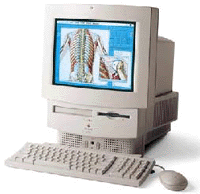 The Performa 580
and 588 were released in April of 1995, and has yet to be discontinued.
They're exactly the same as the LC 580, except for several home-based
enhancements. They're also pretty similar to the rest of the
computers in the 5xx series except for a few different configurations.
The Performa 580 came with System 7.5 preinstalled and also came
with the standard software and modem. The memory was doubled
from the similar LC 580 to 8MB (expandable to 52MB), and the
SCSI hard disk drive was replaced with the cheaper IDE drive,
holding 500MB. The 580 also included TV input/output jacks that
could operate in "mirror mode" like PowerBooks do for
presentations. Besides that, it came with the same processor
as the Performa 575, a 68LC040 running at 33 MHz, the same built-in
14" Trinitron display, and the same single PDS slot and
comm slot, for graphics acceleration or DOS compatiblity, etc.
But overall, Apple designed it with a multimedia slant the multimedia
slant that made preceding models very popular among schools and
home users. The 580 and its counterparts are a great machine
for educational as well as home use. The Performa 580
and 588 were released in April of 1995, and has yet to be discontinued.
They're exactly the same as the LC 580, except for several home-based
enhancements. They're also pretty similar to the rest of the
computers in the 5xx series except for a few different configurations.
The Performa 580 came with System 7.5 preinstalled and also came
with the standard software and modem. The memory was doubled
from the similar LC 580 to 8MB (expandable to 52MB), and the
SCSI hard disk drive was replaced with the cheaper IDE drive,
holding 500MB. The 580 also included TV input/output jacks that
could operate in "mirror mode" like PowerBooks do for
presentations. Besides that, it came with the same processor
as the Performa 575, a 68LC040 running at 33 MHz, the same built-in
14" Trinitron display, and the same single PDS slot and
comm slot, for graphics acceleration or DOS compatiblity, etc.
But overall, Apple designed it with a multimedia slant the multimedia
slant that made preceding models very popular among schools and
home users. The 580 and its counterparts are a great machine
for educational as well as home use. |
Specifications:
Processor: Motorola 68LC040 running at 33 MHz.
Memory:
came with 8MB of RAM expandable to an 8MB.
Drives:
included an built-in Apple SuperDrive 1.4MB floppy drive, a CD-ROM
drive, and an internal 500MB IDE hard drive.
Expansion:
1 PDS slot, 1 Comm slot.
Ports:
included two ADB ports, two mini-circular 8 serial (RS-422) ports,
and one DB-25 SCSI port. ADB Keyboard and mouse included.
Display:
Had a built-in 14" Mac Color Display, supporting only 640x480.
Operating Systems:
Mac OS: comes with System 7.5 preinstalled, supports System
7.5-7.51, 7.53-8.1.
ProDOS:
all versions via IIe PDS card or emulation.
GS/OS:
all versions via IIe PDS card or emulation.
On the market for:
2 years (not yet discontinued)
Resources and Related Links:
Apple's Technical Information
Library
David Pogue's and Joseph Schorr's Macworld
Mac SECRETS.
Picture above from A
History of Apple Computer.
 The Performa 580
and 588 were released in April of 1995, and has yet to be discontinued.
They're exactly the same as the LC 580, except for several home-based
enhancements. They're also pretty similar to the rest of the
computers in the 5xx series except for a few different configurations.
The Performa 580 came with System 7.5 preinstalled and also came
with the standard software and modem. The memory was doubled
from the similar LC 580 to 8MB (expandable to 52MB), and the
SCSI hard disk drive was replaced with the cheaper IDE drive,
holding 500MB. The 580 also included TV input/output jacks that
could operate in "mirror mode" like PowerBooks do for
presentations. Besides that, it came with the same processor
as the Performa 575, a 68LC040 running at 33 MHz, the same built-in
14" Trinitron display, and the same single PDS slot and
comm slot, for graphics acceleration or DOS compatiblity, etc.
But overall, Apple designed it with a multimedia slant the multimedia
slant that made preceding models very popular among schools and
home users. The 580 and its counterparts are a great machine
for educational as well as home use.
The Performa 580
and 588 were released in April of 1995, and has yet to be discontinued.
They're exactly the same as the LC 580, except for several home-based
enhancements. They're also pretty similar to the rest of the
computers in the 5xx series except for a few different configurations.
The Performa 580 came with System 7.5 preinstalled and also came
with the standard software and modem. The memory was doubled
from the similar LC 580 to 8MB (expandable to 52MB), and the
SCSI hard disk drive was replaced with the cheaper IDE drive,
holding 500MB. The 580 also included TV input/output jacks that
could operate in "mirror mode" like PowerBooks do for
presentations. Besides that, it came with the same processor
as the Performa 575, a 68LC040 running at 33 MHz, the same built-in
14" Trinitron display, and the same single PDS slot and
comm slot, for graphics acceleration or DOS compatiblity, etc.
But overall, Apple designed it with a multimedia slant the multimedia
slant that made preceding models very popular among schools and
home users. The 580 and its counterparts are a great machine
for educational as well as home use.